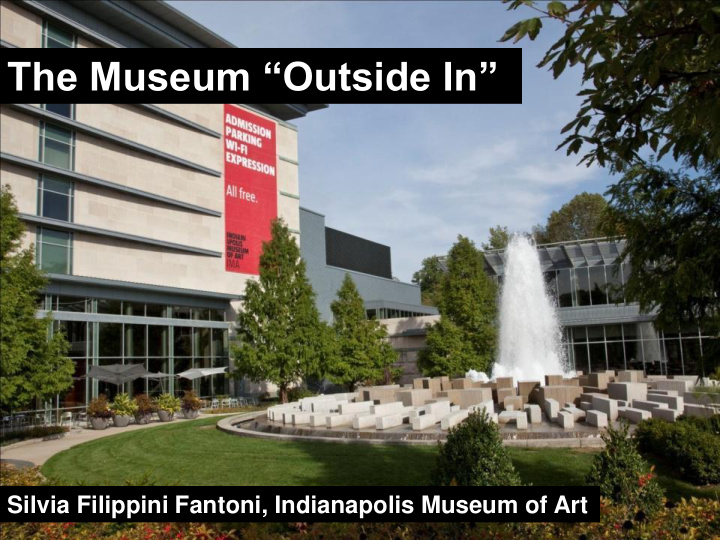



The Museum “Outside In” Silvia Filippini Fantoni, Indianapolis Museum of Art
The Collection
User-centred Approach Visitor-Centered Approach
Visitor-Centricity at the IMA • Implementation of a new exhibition development model • Creation of an audience research and evaluation team • Development of participatory projects
New Exhibition Development Process
Principles • Make the exhibition development process more collaborative from the start by including representatives from various departments, who contribute different perspectives. • Include representatives of Evaluation and Interpretation who are charged with prioritizing the needs and interests of visitors and who ensure that learning theories are applied to the process. • Identify early in the process the exhibition’s main thesis (big idea) and learning outcomes and use these as a reference to develop interpretive material, gallery design and layout, criteria to evaluate success. • Incorporate testing and evaluation at the various steps of the exhibition development process, to guarantee that visitor feedback is taken into account.
Objectives • Make exhibitions more accessible to visitors, particularly those that have little or no previous knowledge of art or art history. • Increase visitors’ engagement with artworks and the institution, as well as their understanding of art. • Increase visitors’ satisfaction with their experiences. • Attract new audiences and increase repeat visitation.
Exhibition Proposal Process Proposal is Preliminary Approval by presented Core team Proposal*. Exhibition by curator. is Curatorial Committee and Exhibition established meeting scheduling. Committee discussion. vet and approve.** Front-end evaluation: Test visitors’ interest in topic/concept (if appropriate) Core team Staff from various depts. Senior management or exhibition committee Curatorial staff
Exhibition Development Process Graphic Interpretation Design Exhibition Formative Plan *** Big idea (cont.) Layout evaluation Document with ** visitors* Content Evaluation Checklist develop- Plan finalized ment Exhibition Activity Committee develop- vet and ment approve Core team Department staff Senior management or exhibition committee
Big Idea • The landscapes and rich cultural traditions of the Southwest fueled the imaginations of early 20 th century artists like Georgia O’Keeffe. The evocative still life paintings produced by these artists provide a fascinating example of art’s capacity to document the essence of a place.
Learning Outcomes • The Southwest art scene : Visitors will learn about the early 20 th century phenomenon of artists visiting the Southwest • Southwestern culture : Visitors will learn more about the context and culture of the Southwest • Artistic approach/style : Visitors will explore the varied approaches to still-life painting employed by Georgia O’Keeffe and her contemporaries • About O’Keeffe : Visitors will explore Georgia O’Keeffe’s life, career, and fascination with the Southwest • Defining still life : Visitors will expand their understanding of what a still-life is and what it can convey.
Interpretive Plan
Text Content Development Process Interpretation Proof Revision First draft Revision by Production Plan review by by Editor by Curator Interpretation by Design & Editor Layout Test sample labels with Installation visitors (if appropriate) * This includes labels, wall-graphics, didactics, other text-based interpretation.
Audiovisual Content Development Interview Interpretation Editing by questions by Interviews Revision Media Plan Interpretation or filming by Curator Producer Revision by Curator Upload content Test with Installation into technology visitors tool (if appropriate)
Participatory & Hands on Experiences Approval by Concept Specification Interpretation Core team Proposal by Review by & Design Plan and Interpretation core team Conservation Test prototype with visitors Test with visitors Development or Installation (if necessary) Fabrication
Challenges Benefits • Resistance mostly from • Increased visitor satisfaction curatorial staff – Fear that exhibition is • New ways of measuring dumbed down success – Fear that interpretation tools might distract the visitor from experiencing art • Key messages are • Resistance from other communicated more organizations (canned effectively shows) that are not willing to modify their show • Better integration and • More time-consuming usage of interpretative and • More contentious participatory experiences
Audience Research & Evaluation
Front-End: Automobile Design n=576 35% 31% 30% 27% 25% 21% 21% 20% 15% 10% 5% 0% Art Deco Duesenbergs Automobile Concept Cars Automobiles Masterpieces
Formative: Robert Indiana Visitors’ interests: • Artist’s life (30/40) • Inspiration (30/40) • Process/technique (26/40) • Artist’s or other’s explanation about the meaning behind the work (7/40)
Formative: Star Studio Focus Group
Remedial: Prototype Testing www.imamuseum.org/autoportrait
Summative: Exhibition Evaluations • Assess if learning outcomes have been met • Assess if expectations regarding level of satisfaction, and use of interpretive tools have been met • Identify problems that might be addressed in future exhibitions • Audience demographics & psychographics
Snapshot Exhibition Observation
Elements Used Extended Labels Simple Labels Artworks 70% 60% % Usage of Exhibition Elements 50% 40% 30% 20% 10% 0% 1 2 3 4 5 6 7 8 Gallery # • Gallery 2 had the highest percentage of observed element usage in the exhibition • The biggest drop in the percentage of elements used is after gallery 5, this is particularly true for extended labels and artworks
Creating Participatory Experiences
Participatory Experiences: Why? • Engage visitors in innovative ways • Develop new audiences • Reinforce the perception of a museum as a more inclusive organization
MY SNAPSHOT
View entries by: - Most popular - Most recent - Most viewed Search for topic, photographer, title Browse by popular tags
Embed, Share, Flag Vote View related photos Comment using Facebook account
Onsite Component
Key Numbers • 2,681 photos submitted • 552 photographers • 33,000 visit to the website • 11.3% of photos with comments • Most Popular : 2,897 votes
Inspired by Matisse
IMA: https://www.imamuseum.org/inspiredbymatisse/
Key Numbers • 3,922 drawings submitted • 30,709 , visits • Most popular: 1,457 votes • 3% of drawings with comments
Create Your Autoportrait
http://www.imamuseum.org/autoportrait
Key Numbers • # of autoportraits made: 3,706 • Survey: – 40% of exhibition visitors have created an autoportrait • 4,132 visits online by 1,248 visitors
Pointillize Yourself
Questions? sfantoni@imamuseum.org
Recommend
More recommend